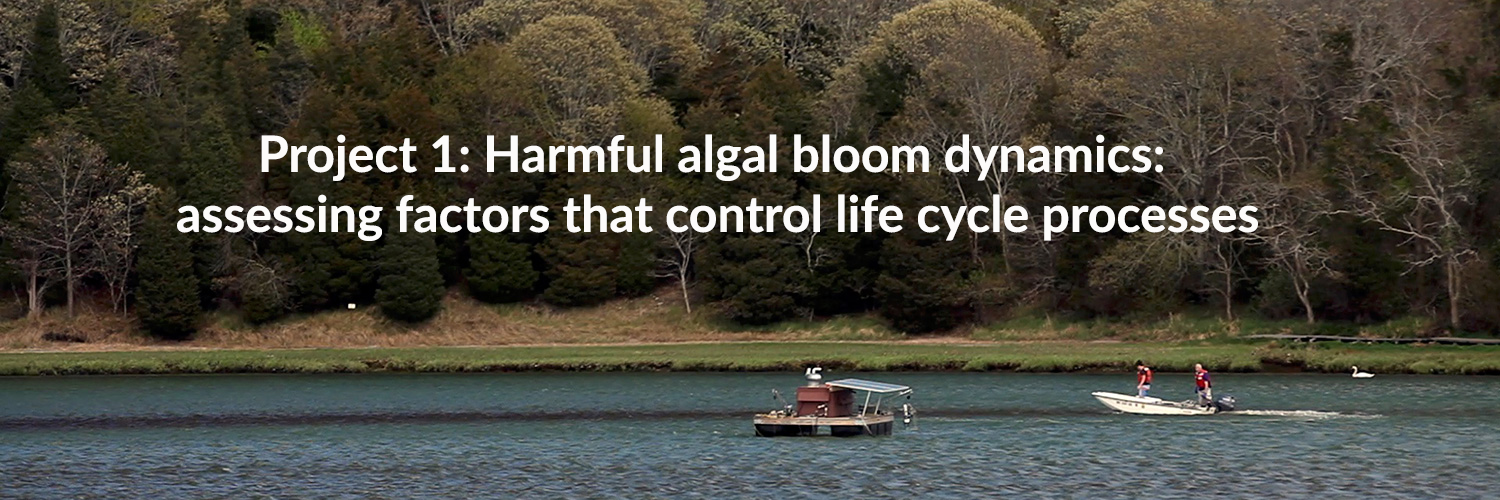
Michael Brosnahan, Don Anderson, Harriet Alexander, and Katherine Hubbard (Florida Fish and Wildlife Conservation Commission)
Project 1 investigates the factors that control life cycle processes in two toxic HAB species–Alexandrium catenella and Pseudo-nitzschia australis–within open waters of the Gulf of Maine (GOM ). Our overarching hypothesis is that life cycle processes are central to long term trends in HAB risks related to the environment and biogeochemistry of the GOM. At the same time, toxin dynamics and dispersal during bloom events is driven by the specific ecological and environmental stimuli encountered by cell populations..
Specific Aims:
Aim 1. Investigate spatiotemporal patterns of cyst dormancy cycling in A. catenella and their relationship to bloom timing and duration across habitats.
Dormancy cycles in A. catenella cysts are driven by year-round temperature conditioning. New statistical models will characterize the distribution of cycling rates for assessments of the adaptability of different cyst populations to changing bottom water conditions. Large variance in dormancy cycle timing is anticipated across GOM cyst beds due to differences in temperature seasonality across this expansive habitat. Refined models of dormancy cycling will be validated through sediment incubations and used for assessment of likely changes to bloom source locations from changing bottom water temperatures. The extent to which dormancy cycles also limit the duration of inshore blooms will be assessed through studies in Nauset Marsh (NM) and Lombos Hole (LH).
Aim 2. Determine conditions promoting new cyst production and other termination processes in GOM A. catenella blooms.
Use of automated sensor systems in the study of localized NM blooms has shown that termination there is overwhelmingly driven by new cyst production and dispersal. Mass sexual induction in NM is exclusively associated with exceptionally high and ephemeral cell concentrations that are only efficiently detected through continuous observing. Accordingly, the applicability of NM-type dynamics to the GOM will be explored through deployment of automated systems that provide continuous, high frequency observations of phytoplankton communities, water column structure, and thin layers of enhanced biomass. Real-time data telemetry will guide adaptive sample collection from ships and regular sediment sampling will determine the timing and intensity of new cyst production within overlying waters. Parallel sampling will assess grazing pressure and nutrient limitation as alternative factors that may induce gametogenesis and/or drive GOM A. catenella bloom termination.
Aim 3 Investigate factors driving long term and intrabloom dynamics of GOM Pseudo-nitzschia bloom toxicity.
Pseudo-nitzschia occur year-round in the GOM. Bloom and toxin dynamics are driven by large-scale hydrographic and environmental forcings as well as life-history transitions that renew bloom populations. The latter will be explored through combined IFCB and automated ribosomal intergenic spacer analysis (ARISA) to track cell size changes within individual Pseudo-nitzschia spp. Abrupt size increases can indicate recent and widespread sexual renewal. In parallel, a series of metatransciptomic studies will leverage continuous IFCB and ESP observing to determine drivers of P. australis growth and toxin dynamics along the Maine coast.
All aims leverage the ongoing build out of a region-scale HAB sensing system (HABON-NE). In situ observation methods are emphasized because prior findings have demonstrated that growth, toxin synthesis, and life history transitions are far more vigorous in situ than in culture.

Integration
The project will assess whether and how newly developed models of A. catenella life cycle processes describe bloom dynamics and phenology in open waters of the GOM. These assessments are essential for modeling (Project 2) and inform consideration of human exposure to HAB toxins (Project 3). New insights will be grounded in observations made through extensive deployments of advanced in situ phytoplankton sensors that provide unprecedented situational awareness during blooms. These data will be shared with stakeholders as they are created through web resources and annual meetings that are developed and organized within the Community Engagement Core.
 WHOI's Harmful Algae Website
WHOI's Harmful Algae Website
A comprehensive resource for information about harmful algal blooms.
 Harmful Algae & Red Tides
Harmful Algae & Red Tides
WHOI Ocean Topics
 Imaging FlowCytobot
Imaging FlowCytobot
Real-Time observation of phytoplankton.